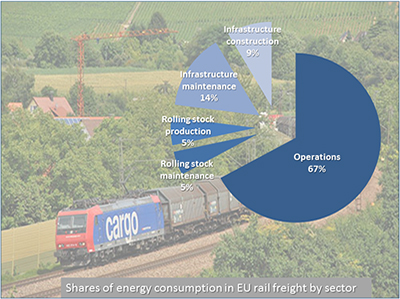
Rail Freight transportation, although energy efficient in comparison to other modes of freight transportation, still has significant potentials for reducing energy use. At the Institute for Transport Planning and Systems (IVT), a research was carried out to identify promising strategies for reducing energy use in Switzerland’s rail freight sector. The results highlighted the need for further research in the network and operational processes, which are the current subjects of IVT’s ongoing research projects in this field.
Although rail freight is generally recognized as an energy-optimal solution for freight transportation, there remain many opportunities to improve its energy efficiency. A recent work conducted at the IVT identifies the main effective strategies for implementing and improving energy efficiency of rail freight transportation. In general, there are two types of energy used in the rail freight production processes: direct energy used for operations, and indirect energy (often called grey energy) used for the production and maintenance of infrastructure and rolling stock. The strategies for improving energy efficiency of rail freight transport can be classified into short-term and long-term categories. Long-term strategies include rolling stock and infrastructure improvements which depend on the long innovation cycles in rolling stock and construction; currently, main studied measures for reducing energy in this area focus on application of electrified networks in the rail sector and the recovery of braking energy using electric brakes. Short-term strategies result in increased energy efficiency fairly quickly; these include scheduling and network design, where the interaction between freight and passenger trains can be re-planned, as well as improvement of operations in terms of deploying driver assistant systems, and adaptive train control.
In particular, rail freight can take high advantages from optimized planning & operation processes. Optimization of freight traffic circulation and freight train motion can bring undisputable benefits to the entire system. Unlike passenger trains, freight trains do not have strong constraints on departure and arrival times, and Origin-Destination paths can be modified according to traffic conditions and/or specific needs. Benefits are evident; freight train rescheduling in low demand hours or rerouting on different paths with less train circulation can increase voltage regularity. Moreover, the ride regularity increases as a result, leading to fewer unplanned stops and the possibility to optimize train speed profiles in an energy efficient way.
Currently, the ongoing research at IVT aims at filling this gap in the energy consumption of rail freight sector. The main target is to define energy efficiency strategies for freight trains through an integrated approach that consider optimization of network, rescheduling procedures, and speed profiles.
Dr. Valerio de Martinis, Dr. Mahnam Saeednia, and Dr. Dirk Bruckmann are scientific collaborators at the Institute for Transport Planning and Systems (IVT), ETH Zürich.